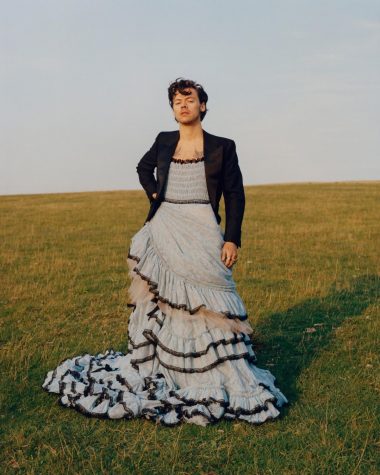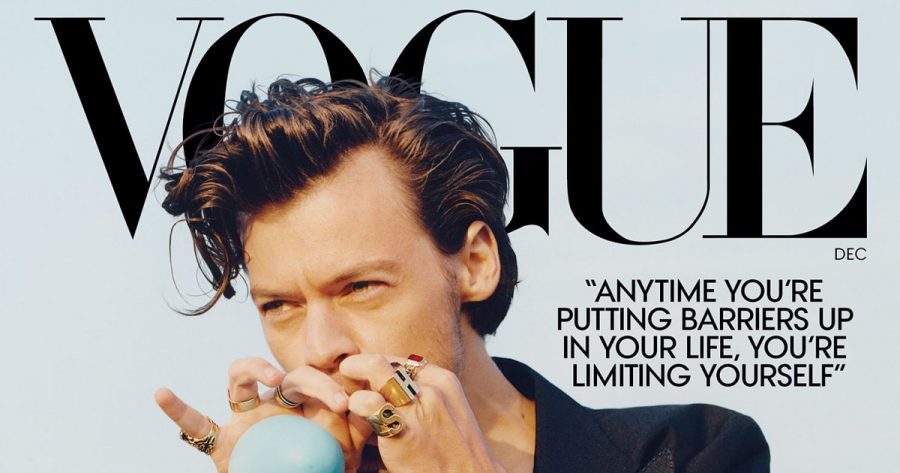“Bring Back Manly Men”: Harry Styles Vogue 2020 Controversy
December 10, 2020
“Bring Back Manly Men” was the rallying outcry coming from conservative outlets, and notoriously that of author Candace Owens who recently slammed iconic musician, Harry Styles, over his famous December issue of Vogue featuring him in a dress. What was so controversial you may ask? Well, the problem lies within the fact that Miss Owens firmly believes “manly men” should not be wearing dresses or perpetuate that the idea is okay, while others came to Harry’s defense claiming the opposite. The long-drawn-out debate over what things, particularly clothing, is considered feminine and masculine has stirred the pot quite a bit in America and many are beginning to take sides. While some argue that dresses are only for women and that men should stick to more “manly ways” by choosing outfits that include a shirt and pants, others argue that clothing has no defined gender. Interestingly, Vogue’s most recent cover feature is the catalyst shining a new light on the debate.
In December 2020 Harry Styles became the first man to grace the covers of Vogue alone. If that wasn’t an accomplishment enough, the singer was also hailed for breaking gender stereotypes by appearing on the cover in a long flowing dress, something not frequently done by men. While I, and so many others, think this a great breakthrough in the world of toxic masculinity and patriarchy that tells men what is and isn’t manly, those on the more conservative side seem to disagree. The most vocal thus far has been none other than the conservative author, Candace Owens, who referred to the cover as the “steady feminization of men” and made a call for the comeback of “manly man.” This tweet confused me as many others who were wondering how an article of clothing could make a man more or less “manly” (as Miss Owens puts it). She later insisted that she was quote on quote, “not sorry” for saying what she did about the musician and further reiterated her belief that men just “can’t” wear dresses. She was supported by her right-wing peer Ben Shapiro who stated, “Anyone who pretends that it is not a referendum on masculinity for men to don floofy dresses is treating you as a full-on idiot.” Despite the harsh criticism, Styles responded with a simple Instagram post featuring him in the glorious dress mockingly captioning it using a quote from none other than Miss Owens herself, “Bring Back Manly Men.”
So what do clothes have to do with masculinity/femininity? And why was Harry Styles’ outfit of choice so groundbreaking? Well, there are many different perspectives to look at this from. Despite the hate coming from the right-wing, it is clear many of Harry Styles fans, friends, and family not only support his style choice but also hail him as a hero for being so bold. For years, the idea has been perpetuated that if you want to look like a man you dress one way, while if you want to look like a woman you dress another. However, as we move into 2021, many are ready to leave behind the gender labels both invisibly and visibly attached to clothes so that people can dress however they want without being judged. We as a society have been taught that dresses, skirts, and blouses have been designed for women, while clothing like button-ups, khakis, pants (of any kind), etc. are meant to be worn by men. This has created an array of problems by forcing both genders to conform to society’s standards of masculine and feminine and has instilled fear in what may happen if they were to step outside of this box of all that is “normal”. Even as you go shopping today, you’ll notice that clothing is displayed by gender, not by color, style, or price, but by what sex we identify as. The way clothing is marketed today is quite problematic in its own right, because who is to say that wearing the color pink makes you any less of a man than wearing blue? Who is to say that a boy wearing a skirt isn’t manly? And who is to say that a girl wearing a pantsuit isn’t feminine?
I don’t think the problem with clothing lies just within gender, but also with weight and respectability as well. Our society tells us that if we are a certain size there are certain clothes that we should collectively avoid. It also instills the idea that if we want to be respected or if we don’t want to be harassed we have to dress “modestly”. I think gender is another really important aspect to look at as well because it institutes this type of unspeakable fear and it makes us question if what we wear makes us seem something we’re not. Gender roles have had a profound effect on the development of the world, as the moment we are born, we are fed our first stereotype which is that blue is for boys and pink is for girls. While that only scratches the mere surface of instituted gender roles, it plays a larger part in how we as a society define what is meant for men and what is meant for women.
Harry Styles appearing on the cover of Vogue in a dress wasn’t simply published to spark a debate or to even offer a new perspective on gender roles, but rather to normalize the idea that men can still wear items like dresses and skirts and still be “men.” The idea that wearing an item of clothing designed for women strips a man of his brisk “manliness” and is “wrong” insinuates not only that our identity is based on what kind of clothes we wear, but also that there are rules and regulation to how we can clothe ourselves. The same goes for women everywhere who have been shamed for wearing clothes typically marketed towards men like suites, basketball shorts, certain sneakers, etc. Despite what Candace Owens and her supporters may say, I believe that a man like Harry Styles (who has the respect of many), wearing a dress on the cover of a major magazine like Vogue opened the eyes of boys and men everywhere and gave them a new perspective to the way they can dress. Of course, we can’t forget that Harry Styles wasn’t the first man to break down this toxic masculinity barrier, other celebrity men such as David Bowie, Freddie Mercury, Jaden Smith, Brad Pitt, A$AP Rocky, Elton John, Prince, Kurt Cobain, Lil Nas X, Bad Bunny, and Jonathan Van Ness also challenged these gender stereotypes by wearing clothes not typical to men. I mean, who could forget Bill Porter’s stunning dress he wore to the 2019 Oscars?
Overall, I firmly believe that as a society we have evolved beyond the need to restrict clothing types to gender and should support the fact that men can wear dresses and women can wear suits and still embody their chosen gender. I suppose there will always be critics like Candace Owens and Ben Shapiro amongst others who will find ways to tear down others for the way they chose to express themselves. It is unfortunately inevitable. However, I think if Harry Styles has taught us anything with this amazing cover, it’s that dresses don’t “belong” to a specific gender, it belongs to the individual bold enough to rock it.

**This opinion article reflects the voice of the writer and does not necessarily represent the views of The Viking Times as a whole. Like most news outlets, The Viking Times is a non-partisan media platform.**




Debra • Dec 17, 2020 at 1:00 am
I’m not sure that that I would go out on a date with a guy who wears a dress either. However, you have your finger on the pulse of the nation right now and it’s a very thought provoking commentary. Well done.
Ms. Kelley • Dec 14, 2020 at 1:17 pm
Well said, Analise!! Great job!
Mrs. Summa • Dec 14, 2020 at 12:14 pm
In today’s society I believe that anything goes. . . we’ve come a long way . But I must admit that I do like a guy to dress like a guy. I wouldn’t want to go on a date with someone and have my guy be wearing a prettier dress than I am wearing! (Lol)
It’s not outside that counts, it’s what is on the inside that counts; kindness and being a good person is what really matters not what you wear..
Analise, this is a great report and you had my thinking process really going! Awesome job!